Chiefs And Leaders
Shíipdeetash/No Intestines or No Vitals (mid-1400’s) His vision of the sacred Tobacco seed led to our migration from Spirit (Devils) Lake to Crow Country.
Chíitdeehisshish/Red Scout (mid-1400’s) Brother of No Intestines. Based on his vision of corn seed, his band settled on the Missouri River to become the Hidatsa.
Ishtúwatash/One Eye or Iispeelatchísh/Raven Face (late 1400’s)
Axúachisshish/Paints His Shirt Red (early 1500’s)
Búahisshish/Red Fish (mid 1500’s) During the time of this leader, the Apsáalooke came to have a ready supply of obsidian. Undoubtedly, this meant we came to control the obsidian mines in present-day Yellowstone Park.
Búattaaxalusshish/Running Coyote (late 1500’s) Through instructions received in a vision, this leader developed the buffalo jump for procuring meat.
Daasáwatash/One Heart (early 1600’s) The population of our people had grown and we were prosperous. This leader was killed by One Eye for murdering his brother.
Isahpíishchoosish/White Moccasin Top (mid 1600’s)
Daxpitchée Daasítchileetash/Bear Whose Heart Is Never Good (mid-1600’s) Following a dispute over the distribution of a buffalo paunch, this leader separated his group from the Hidatsa and joins the Ashalahó/Many Lodges in Crow Country. His followers became the historic River Crow band.
Chíilapkalishtachiash/Young White Buffalo (late 1600’s) During the time of this leader, we obtained our first steel knives from the Hidatsa. This leader was also the first to bring horses to the Apsáalooke.
Iisaakiiwaanníash/Plays With His Face (early 1700’s) A fearless leader who once escaped certain death at the hands of the enemy by jumping off a cliff, and using his buffalo robe like a parachute.
Itchuuwaaóoshbishish/Red Plume (Feather) At The Temple (born ca. 1750, died in 1836) A Mountain Crow leader during fur trade days and signer of the 1825 Friendship Treaty. Traders and trappers called him Long Hair because of his extraordinarily long hair, approximately 25 feet long. At his death, his hair was cut off and maintained by Tribal leaders. The long lock of hair is now curated by the Chief Plenty Coups State Park at Pryor, Montana.
Eelápuash/Sore Belly or Rotten Belly (1795-1834) A River Crow leader, a contemporary of Red Plume (Feather) At The Temple. He refused to sign the 1825 Friendship Treaty.
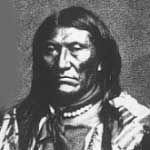 Awé Kúalawaachish/Sits In The Middle Of The Land, also known as Káamneewiash/Blood Woman and Blackfoot/Iché Shipíte (1795-1877) The principal Crow leader in the mid-1800’s. He used the metaphor of the four base tipi poles to describe the borders of Crow Country.
Awé Kúalawaachish/Sits In The Middle Of The Land, also known as Káamneewiash/Blood Woman and Blackfoot/Iché Shipíte (1795-1877) The principal Crow leader in the mid-1800’s. He used the metaphor of the four base tipi poles to describe the borders of Crow Country.
Daxpitcheehísshish/Red Bear (around 1807 to 1860s) A noted Mountain Crow chief and warrior during the 1840’s and 1850s.
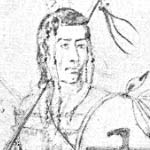 Chíischipaaliash/Twines His (Horse’s) Tail or Rotten Tail (about 1800 to 1867) Leader of the River Crow band during the 1840’s and head chief of the Crow Tribe during the 1850’s and 1860’s; an outstanding medicine man and war party commander (pipe carrier).
Chíischipaaliash/Twines His (Horse’s) Tail or Rotten Tail (about 1800 to 1867) Leader of the River Crow band during the 1840’s and head chief of the Crow Tribe during the 1850’s and 1860’s; an outstanding medicine man and war party commander (pipe carrier).
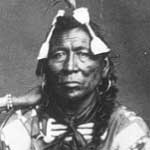 Itchúua Chíash/White Temple, known also as Iron Bull/Uuwatchiilapish (ca. 1820-1886) An important warrior and second ranking chief to Sits In The Middle Of The Land.
Itchúua Chíash/White Temple, known also as Iron Bull/Uuwatchiilapish (ca. 1820-1886) An important warrior and second ranking chief to Sits In The Middle Of The Land.
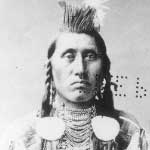 Déaxitchish/Pretty Eagle (1846-1905) A reservation-era leader who was recognized by 1890 along with Plenty Coups as head chief of the Crow Tribe.
Déaxitchish/Pretty Eagle (1846-1905) A reservation-era leader who was recognized by 1890 along with Plenty Coups as head chief of the Crow Tribe.
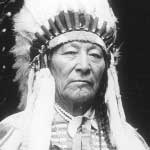 Alaxchiiaahush/Many War Achievements or Plenty Coups, known also as Chíilaphuchissaaleesh/Buffalo Bull Facing The Wind (1848-1932) Mountain Crow leader, visionary, diplomat, and last principal chief of the Crow Tribe.
Alaxchiiaahush/Many War Achievements or Plenty Coups, known also as Chíilaphuchissaaleesh/Buffalo Bull Facing The Wind (1848-1932) Mountain Crow leader, visionary, diplomat, and last principal chief of the Crow Tribe.
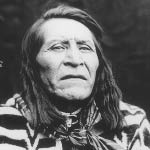 Issaatxalúash/Two Leggings, known also as Apitisée/Big (Whooping) Crane (born mid-1840’s, died in 1923) A prominent River Crow chief, war leader, and reservation-era chief.
Issaatxalúash/Two Leggings, known also as Apitisée/Big (Whooping) Crane (born mid-1840’s, died in 1923) A prominent River Crow chief, war leader, and reservation-era chief.
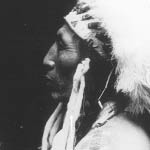 Peelatchiwaaxpáash/Medicine Crow (Raven) A prominent Kicked In The Belly chief, war leader, and reservation-era chief.
Peelatchiwaaxpáash/Medicine Crow (Raven) A prominent Kicked In The Belly chief, war leader, and reservation-era chief.
Biitawuásh/Bell Rock (1842-1932) The greatest war party leader (pipe carrier) of his day and reservation leader.
Women Leaders from the Buffalo Days
Bíawacheeitchish/Woman Chief (ca. 1790-1830) Captured as a girl from the Atsina people and raised by a Crow couple. Became a renowned war and camp leader. She dressed as a man when she went to war and had a number of wives. Her life was chronicled by the fur trader Edwin Denig. She was killed in a battle against her natal tribe in the 1830’s.
Akkeekaahuush/Comes Toward The Near Bank (ca. 1810-1880) She and her husband, Knife, were infamous war leaders. She was once captured by the Piegans in battle and later escaped.
Biliíche Héeleelash/Among The Willows (1837-1912) A prominent war leader known for dressing in the finest female attire when riding into battle. She was one of the leaders (pipe carriers) against the Lakota in the legendary Battle of Rainy Buttes (called the Battle Where Sitting Bull’s Father Was Killed, by the Lakota). She lived into the early reservation period and is an ancestor of the Sings Good family.
[Adapted from, Dale D. Old Horn,and Timothy P. McCleary, Apsáalooke Social and Family Structure. Crow Agency, MT: Little Big Horn College, 1995. Edward S. Curtis, The North American Indian: The Apsaroke and Hidatsa. Volume 4. New York, NY: Johnson Reprint Corporation 1970, original 1909. Joe Medicine Crow, All Time Great Chieftans of the Crow Indians, 1600-1904. In Absaraka. Crow Agency, MT, 1968]
See also: